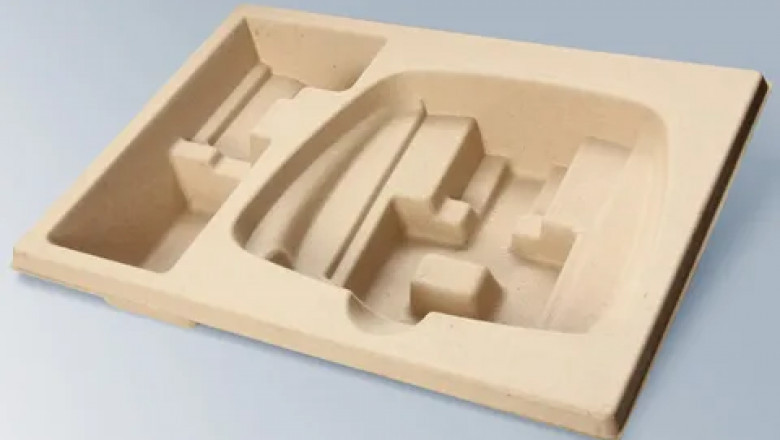views
Molded packaging has become a popular solution in many industries due to its sustainable and protective features. As companies look for innovative, eco-friendly, and cost-effective methods to package their products, molded packaging has emerged as a clear frontrunner. This guide is designed to help beginners understand what molded packaging is, how it works, and why businesses are turning to it as a preferred packaging solution.
Whether you’re a manufacturer, retailer, or simply interested in sustainable packaging, understanding molded packaging is vital. This article breaks down the molded packaging definition, explores its benefits, and highlights its impact on different industries. By the end of this guide, you’ll have a solid understanding of why molded packaging is more than just a trend—it’s a smart, long-term solution for modern packaging challenges.
Understanding Molded Packaging: The Basics
The molded packaging definition refers to a process where packaging materials—usually made from molded pulp, paper, or bioplastics—are shaped using molds to form protective, custom-fit containers for products. These packages are often made from recycled materials and formed to fit the specific shape of the product they are protecting. This molding technique is especially popular for items like electronics, glassware, industrial components, and even food products, as it provides both cushioning and structural support.
Molded packaging differs from traditional methods such as cardboard boxes or plastic blister packs. It’s crafted in a way that conforms to the product's contours, minimizing the need for additional protective fillers like foam or plastic. This makes it not only efficient in space usage but also in material consumption. At its core, the molded packaging definition emphasizes sustainability, protection, and efficiency—qualities that are increasingly essential in modern logistics and retail.
The Environmental Benefits of Molded Packaging
One of the most significant advantages molded packaging offers is its positive environmental impact. Because it is typically produced using recycled materials like newspaper, cardboard, or even agricultural waste, the carbon footprint associated with its manufacturing is far lower than that of plastic or Styrofoam alternatives. Additionally, molded packaging is biodegradable and compostable, meaning it will break down naturally over time without harming the environment.
In contrast, conventional plastic packaging can take hundreds of years to decompose and often ends up in landfills or oceans. Molded packaging, however, aligns with the principles of a circular economy, where products are designed to be reused, recycled, or safely returned to the environment. For eco-conscious businesses and consumers, the molded packaging definition embodies a commitment to reducing waste and promoting sustainable practices.
Functional and Protective Advantages
Aside from being eco-friendly, molded packaging is highly functional and offers excellent protection for products. Thanks to its tailored design process, it provides a snug fit for fragile items, ensuring minimal movement during shipping. This reduces the likelihood of damage, returns, or customer dissatisfaction. Whether shipping delicate electronics or heavy mechanical parts, molded packaging offers superior shock absorption and vibration resistance.
Furthermore, molded packaging is resistant to temperature changes and moisture, adding another layer of security. This makes it an ideal choice for products that may be exposed to various environmental conditions during transit. The molded packaging definition isn’t just about form—it’s about function as well. With its ability to serve both protective and aesthetic purposes, it is an excellent choice for brands looking to improve product safety and customer experience.
Applications Across Different Industries
Molded packaging is widely used across various industries, highlighting its versatility. In the electronics sector, molded pulp trays and shells are often used to encase items like smartphones, tablets, and accessories. The fit-to-form design ensures the products remain secure and protected from static, shocks, and external damage. Similarly, the cosmetics and personal care industry uses molded packaging for items such as perfumes and skincare products, combining elegance with protection.
The food and beverage sector also benefits from molded packaging, especially for eggs, fruits, and takeout containers. Molded pulp trays are breathable and prevent spoilage, while molded fiber plates and bowls offer an eco-friendly alternative to plastic disposables. The molded packaging definition clearly extends beyond just one niche—its application in diverse industries proves its adaptability and growing importance in the global packaging market.
Cost-Effectiveness and Brand Value
Contrary to the belief that eco-friendly options are expensive, molded packaging can be quite cost-effective in the long run. Because it's made from low-cost recycled materials and often manufactured using efficient processes, production costs are relatively low. Additionally, its custom-fit nature reduces the need for extra packaging materials, saving on material and shipping expenses. When damage claims and returns are minimized due to better protection, the savings are even more significant.
From a branding perspective, molded packaging offers a clean, professional look that resonates with modern consumers. Companies that use molded packaging often signal their commitment to sustainability and quality, boosting customer trust and brand loyalty. In today’s competitive market, packaging is more than just a container—it’s a key part of the customer experience. When companies embrace the molded packaging definition, they’re investing not just in packaging but in brand perception and long-term customer relationships.
Conclusion
Understanding the molded packaging definition is the first step to recognizing its value in today’s environmentally-conscious and quality-driven market. This innovative packaging solution combines sustainability, protection, functionality, and affordability, making it a compelling option for businesses across all sectors. As consumers continue to prioritize eco-friendliness and companies seek to reduce costs without sacrificing product quality, molded packaging emerges as a win-win solution.
For beginners, this guide provides the foundational knowledge needed to explore molded packaging options confidently. Whether you're involved in manufacturing, e-commerce, or retail, adopting molded packaging can significantly improve your product’s safety, reduce environmental impact, and enhance your brand's image. As packaging continues to evolve, those who understand and implement molded packaging strategies today will be well-equipped to meet the challenges of tomorrow.














Comments
0 comment